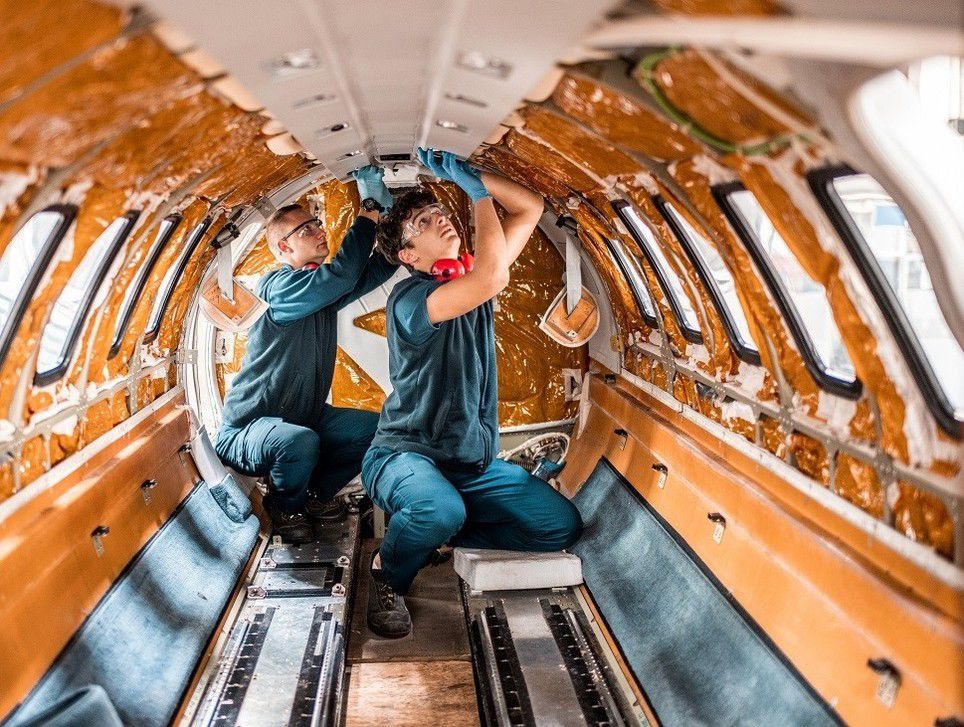At Centurion Jets, we often hear clients ask: “This jet was built in 1999—isn’t it too old?” Not necessarily. Let’s demystify why.
Beyond the “Birthday”: Understanding Aircraft Longevity and Maintenance
Private jets are not like cars. They’re engineered for extreme longevity and are maintained to the highest safety standards through rigorous inspection schedules and mandated overhauls. A well-maintained jet from the early 2000s can be in excellent mechanical and cosmetic condition—sometimes even better than a newer jet that hasn’t been properly cared for.
Unlike a car, where age often directly correlates with wear and tear, an aircraft’s lifespan is dictated by a rigorous and ongoing maintenance schedule. Aircraft are designed to be maintained, not simply to wear out.
* Cycles and Hours: The True Indicators of Use: Aircraft are typically limited by two key metrics:
* Flight Hours: The total time the aircraft has spent in the air.
* Cycles: One “cycle” typically means one takeoff and one landing. Pressurization and depressurization cycles put stress on the fuselage.
These are the numbers that truly matter to aviation professionals, as they directly impact the lifespan of critical components.
* Scheduled Maintenance & Inspections: A Way of Life: Every private aircraft operates under strict maintenance protocols dictated by aviation authorities such as the FAA or EASA. These programs are the bedrock of aviation safety, ensuring that every component meets rigorous airworthiness standards and include:
* A, B, C, and D Checks (or their equivalent): These are progressive inspections ranging from routine checks to complete disassemblies.
* Time Between Overhaul (TBO) and Hours/Calendar-Based Inspections: Critical components are inspected or replaced after a set number of flight hours or calendar years, whichever comes first.
* Phased Inspections: Many aircraft follow a phased inspection program, breaking down large checks into smaller, manageable portions performed at regular intervals.
* Component Lifing: Many components have a finite “life” in terms of hours or cycles, after which they must be replaced, regardless of their apparent condition. This ensures proactive safety and performance.
* Overhauls: The Ultimate Rejuvenation: When components, or even entire engines or landing gear, reach a certain number of hours or cycles, they are removed from the aircraft and sent for a complete overhaul. This is far more than a repair. During an overhaul:
* The component is fully disassembled.
* Every part is inspected, cleaned, and tested.
* Worn or fatigued parts are replaced with new or zero-timed parts.
* The component is reassembled and rigorously tested to meet original manufacturing specifications.
Essentially, an overhauled engine or component is given a new lease on life, often returning to “zero time” since its last overhaul, meaning it’s as good as new from a maintenance perspective. For example, landing gear typically requires an overhaul every 10–12 years.

The Magic of Refurbishment: A Phoenix Rises
This brings us to the year of refurbishment. When an aircraft undergoes a comprehensive refurbishment, it’s not just a cosmetic refresh. It’s a meticulous, in-depth process that often includes:
* Full Disassembly and Structural Inspection: The aircraft is largely taken apart. Seats, cabinetry, floorboards, side panels – even some major systems – are removed. With the interior stripped, technicians have unprecedented access to the aircraft’s underlying structure, allowing them to inspect for corrosion, fatigue, or any other issues that might be hidden during routine inspections. Any issues are addressed and repaired to exacting standards.
* Updated Mechanical Systems: Worn parts are replaced or overhauled, including fuel systems, hydraulics, and wiring. This ensures all critical operational components are in peak condition.
* Modernized Avionics: Outdated avionics (navigation, communication, and control systems) are replaced with the latest technology. Beyond just looking sleek, new avionics systems offer enhanced navigation precision, real-time weather data, and advanced safety features, making flights smoother, more efficient, and reducing pilot workload.
* Engine Overhauls or Replacements: Often, a major refurbishment coincides with scheduled engine overhauls. This means the powerplants are returned to like-new condition, or in some cases, replaced entirely.
* New Interior: This is the most visible change. New leather seats, wood veneer, carpeting, modern lighting, and state-of-the-art entertainment systems are installed, transforming the cabin into a modern, luxurious space.
* Fresh Paint: A new exterior paint job not only looks stunning but also protects the aircraft’s skin from environmental elements.
The result of a thorough refurbishment? An aircraft that is mechanically, structurally, and aesthetically brought up to a condition that is often indistinguishable from, or even superior to, a new aircraft – all while retaining the proven airframe.
Why Refurbishment Matters: Exceptional Value and Peace of Mind?
When an aircraft undergoes a full refurbishment, it is essentially reset—mechanically, structurally, and aesthetically. A jet built in 2002 and fully refurbished in 2022 may look, feel, and perform like a brand-new aircraft. In fact, many savvy buyers and charter clients look for recently refurbished jets because they offer exceptional value:
* Cost Efficiency: A fully refurbished aircraft typically costs significantly less than a brand-new model of comparable size and capability.
* Modernization: With updated avionics and cabin amenities, a refurbished jet can offer the same technological advantages as a new aircraft.
* Reduced Initial Depreciation: The steepest depreciation for any asset, including an aircraft, often occurs in its first few years. A refurbished aircraft has already weathered this initial depreciation, offering better value retention. For those looking to purchase, a recently refurbished jet not only offers immediate benefits but also tends to hold its value better, as the investment in modernization is reflected in its market appeal.
* Proven Airframe: The airframe itself has already demonstrated its durability and reliability over years of operation.
Centurion Jets Only Works With the Best
At Centurion Jets, we carefully vet every aircraft we present to our clients, whether for charter or purchase. We review maintenance logs, refurbishment records, and inspection histories to ensure every flight is as safe, reliable, and luxurious as possible. We prioritize aircraft enrolled in top-tier maintenance programs like CAMP, MSP Gold, or CorporateCare—because your safety and experience come first.
The bottom line: when considering a private aircraft, don’t let the year of manufacture be your sole guide. Instead, focus on the comprehensive maintenance records, the history of overhauls, and most importantly, the scope and quality of any recent refurbishment. It’s an ageless wonder, ready for its next chapter of flight.



